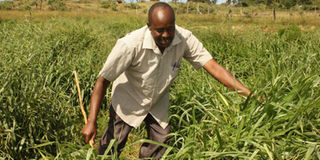Meet Maasai grass, the wonder fodder

Mr. Peter Ole Nembo, in his farm of Brachiaria grass. He is now living a settled life as a farmer. PHOTO | GEOFFREY
What you need to know:
- Scientists are now using the genetic diversity of the once orphaned East African forage crop in research that will help enhance the drought resilient properties of the grass.
- Laina plans to put up a store and acquire a grass cutter, which will help him harvest and store the grass, which he can then sell to his colleagues during the dry spell.
Atropical grass species known as Brachiaria that originated from Kenya, and was improved and embraced by dairy and beef farmers in Brazil, Colombia and Australia is now back into the country.
The grass is already changing the fortunes of livestock farmers in Transmara.
Commonly known as the Maasai, Tanzania and Mombasa grass, the improved species is expected to transform smallholder livestock farming.
“Farmers in the savannahs of Colombia are happy because their milk output has quadrupled and their cattle are much healthier after using a grass that came from Africa,” says Prof Onesmo ole Moiyoi, a scientist at the International Centre for Insect Physiology and Ecology (Icipe).
Prof Moiyoi says the grass was initially taken from the country during the colonial era to as far as Montpelier in France for research purposes.
Scientists are now using the genetic diversity of the once orphaned East African forage crop in research that will help enhance the drought resilient properties of the grass.
“We are hoping to develop resilience by using what is known as endophytes (beneficial micro-organisms growing within the plant),” adds Dr Monday Ahonsi, the Programme Coordinator at the Biosciences Eastern and Central Africa, International Livestock Research Institute, Nairobi.
The scientists are propagating Brachiaria in Kenya and the region to help resource-poor farmers cope with drought as well as create forage seed production enterprises.
In Transmara West sub-county, where the grass has been embraced, farmers are already reaping its benefits. “We used to herd our cows to as far as Kiligoris, some 80km away where rainfall is relatively good, but that is no longer the case because of the grass,” says Leornard Laina, a 25-year-old former Maasai herdsman.
The change of fortune made Laina grow the grass on part of his 12-acre land in his Ntule village.
After selling part of his harvest for Sh2,000, he now sees an entrepreneurial opportunity in the venture.
Forty-three-year-old Peter ole Nembo, a father of six who hails from Kirkamat village of the same county, own 65 heads of cattle and 53 acres of land.
Three-and-a-half acre is now dedicated to growing the grass. Nembo is in his third year since adopting a settled farming life after ditching pastoralism. And he has no regrets.
“I have increased milk production from three litres per cow a day to seven litres,” he says, something which he attributes to cultivating the grass.
Laina plans to put up a store and acquire a grass cutter, which will help him harvest and store the grass, which he can then sell to his colleagues during the dry spell.
It is estimated that 5,000 farmers in Kenya have adopted the new Brachiaria hybrid to provide improved feed source for dairy cattle.
Oscar Magenya, the director of the Kenya Agricultural Research Institute, Kisii centre, explains that the institution in conjunction with International Centre of Insect Physiology and Ecology is experimenting with Brachiaria to replace napier grass in a pest-control technology known as push-pull. In this technology, the ‘push plant’ (desmodium), which is the inter-crop leguminous plant produces chemicals that repel the stem borer from the farm.
This pest is responsible for up to a third of maize failure in East Africa.
Brachiaria could have greater impact on climate change besides serving as a fodder crop.




